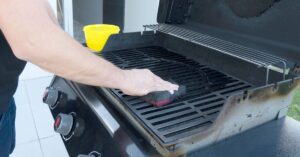In the realm of household cleaning, vinegar has long been a trusted ally. However, when it comes to choosing the right vinegar for the job, confusion can arise. Is cleaning vinegar the same as white vinegar? This question has sparked much debate among homeowners and cleaning enthusiasts alike. In this article, we will delve into the composition, manufacturing processes, and practical uses of both cleaning vinegar and white vinegar, providing you with the knowledge needed to make an informed decision. Join us on this journey of discovery and find your place in the world of vinegar-based cleaning solutions. Looking for the proper method for cleaning dirty utensils? We’ve got you covered!
Key Takeaways
- Cleaning vinegar and white vinegar have similar compositions but differ in terms of acetic acid concentration and additional ingredients.
- Cleaning vinegar is more acidic than white vinegar, with a lower pH level.
- Cleaning vinegar is effective for various cleaning applications and has additional uses such as laundry stain removal and pet stain cleaning.
- White vinegar is more readily available and versatile, while cleaning vinegar is specialized and may be more expensive.
Composition of Cleaning Vinegar and White Vinegar
The composition of cleaning vinegar and white vinegar differs in their respective chemical formulations. While both types of vinegar contain acetic acid as the main component, cleaning vinegar typically has a higher concentration of acetic acid compared to white vinegar. This higher concentration of acetic acid in cleaning vinegar gives it enhanced cleaning properties, making it more effective in removing tough stains and grime. In addition to acetic acid, cleaning vinegar may also contain other ingredients such as water and natural cleaning agents, which further contribute to its cleaning abilities.
These additional ingredients are carefully chosen to ensure maximum cleaning power while maintaining the safety and eco-friendliness of the product. Understanding the differences in composition between cleaning vinegar and white vinegar is crucial in determining their respective uses and effectiveness in various cleaning applications. Moving forward, let’s now explore the differences in manufacturing processes for these two types of vinegar.
Differences in Manufacturing Processes
Cleaning vinegar and white vinegar are manufactured using distinct processes, with cleaning vinegar being produced more frequently than white vinegar. The differences in manufacturing processes between the two types of vinegar can impact their properties and potential uses. Here are four key distinctions to consider:
- Cleaning vinegar is often made from the fermentation of fruits or grains, while white vinegar is typically produced from the fermentation of distilled alcohol.
- Cleaning vinegar may undergo a more intensive filtration process to remove impurities and sediments.
- White vinegar may go through additional steps, such as pasteurization or distillation, to achieve a higher level of purity.
- Cleaning vinegar may have a lower acetic acid content compared to white vinegar, which can affect its cleaning effectiveness.
Understanding these variations in manufacturing processes helps to elucidate the divergent characteristics of cleaning vinegar and white vinegar. Now, let’s explore another important aspect: the pH levels of these two types of vinegar.
Ph Levels of Cleaning Vinegar Vs White Vinegar
The pH levels of cleaning vinegar and white vinegar differ in their acidity. While both types of vinegar are acidic, the pH level of cleaning vinegar is typically lower than that of white vinegar. This difference in acidity can impact their effectiveness in various cleaning applications.
To better understand the pH levels of cleaning vinegar and white vinegar, let’s compare them in the table below:
| Vinegar Type | pH Level |
|---|---|
| Cleaning Vinegar | 2-3 |
| White Vinegar | 2.4-3.4 |
As shown in the table, cleaning vinegar generally has a pH level between 2 and 3, whereas white vinegar falls within the range of 2.4 to 3.4. This slight difference in pH can influence their cleaning properties, making them more suitable for specific tasks.
It’s important to note that the pH levels mentioned above are approximate and can vary slightly between different brands or batches of vinegar.
Practical Uses and Applications
One common practical use for both cleaning vinegar and white vinegar is in cooking and food preparation. Both types of vinegar can add flavor to dishes, enhance marinades, and act as a natural preservative for pickling. However, cleaning vinegar has additional applications beyond the kitchen. Here are four practical uses and applications for cleaning vinegar:
- Household cleaning: Cleaning vinegar is an effective and natural alternative to chemical-based household cleaners. It can be used to remove stains, grease, and odors from various surfaces, including countertops, floors, and windows.
- Laundry: Adding a small amount of cleaning vinegar to the laundry can help remove stubborn stains and odors from clothes and towels.
- Pet care: Cleaning vinegar can be used as a pet-friendly cleaning solution for removing pet stains and odors from carpets and upholstery.
- Gardening: Diluted cleaning vinegar can be used as a natural weed killer and to remove mineral deposits from garden tools and pots.
These are just a few examples of the practical uses and applications for cleaning vinegar beyond its role in cooking and food preparation.
Cost and Availability Comparison
When comparing the cost and availability of cleaning vinegar and white vinegar, it is important to consider factors such as price and accessibility. Cleaning vinegar is typically more expensive than white vinegar, primarily due to its higher acidity and specialized formulation for cleaning purposes. White vinegar, on the other hand, is readily available in most grocery stores and is often more affordable.
To provide a clearer comparison, the table below outlines the cost and availability of cleaning vinegar and white vinegar:
| Factor | Cleaning Vinegar | White Vinegar |
|---|---|---|
| Price | Higher | Lower |
| Accessibility | Limited | Widely available |
| Versatility | Specialized | Multi-purpose |
From the table, it can be seen that cleaning vinegar is pricier and less accessible compared to white vinegar. However, cleaning vinegar is specifically formulated for cleaning tasks, while white vinegar has a wider range of applications. Ultimately, the choice between the two depends on the intended use and personal preference.
FAQ,s
Can Cleaning Vinegar Be Used for Cooking or Food Preparation?
Cleaning vinegar is a versatile household cleaner that can be used for various cleaning purposes. However, it is not recommended for cooking or food preparation due to its higher acidity and potentially harmful additives.
Is White Vinegar Safe to Use as a Household Cleaner?
White vinegar is safe to use as a household cleaner due to its acidic properties, which help break down dirt and grime. However, it is important to dilute it properly and avoid using it on certain surfaces, such as marble or stone.
Does Cleaning Vinegar Have a Stronger Smell Compared to White Vinegar?
Cleaning vinegar may have a stronger odor compared to white vinegar. Its unique formulation, intended for cleaning purposes, may result in a more pungent smell. However, further investigation is required to provide a definitive answer.
Can White Vinegar Be Used for Gardening or Plant Care?
White vinegar can indeed be used for gardening and plant care. Its acidic nature helps to control pests, remove weeds, and create a favorable pH level for certain plants. However, it is important to dilute it properly to avoid damaging plants.
Are There Any Potential Health Hazards Associated With Using Cleaning Vinegar or White Vinegar?
Cleaning vinegar and white vinegar are often used interchangeably, but they are not the same. Cleaning vinegar has a higher acidity level, making it more effective for cleaning purposes. However, both vinegar types can pose potential health hazards if not used properly.
Conclusion
In conclusion, cleaning vinegar and white vinegar are not the same. They differ in composition, manufacturing processes, pH levels, and practical uses. Cleaning vinegar is specifically formulated for cleaning purposes and has a higher acidity level, while white vinegar is more commonly used for culinary purposes. Understanding these differences can help individuals make informed choices when selecting the appropriate vinegar for their specific needs.










